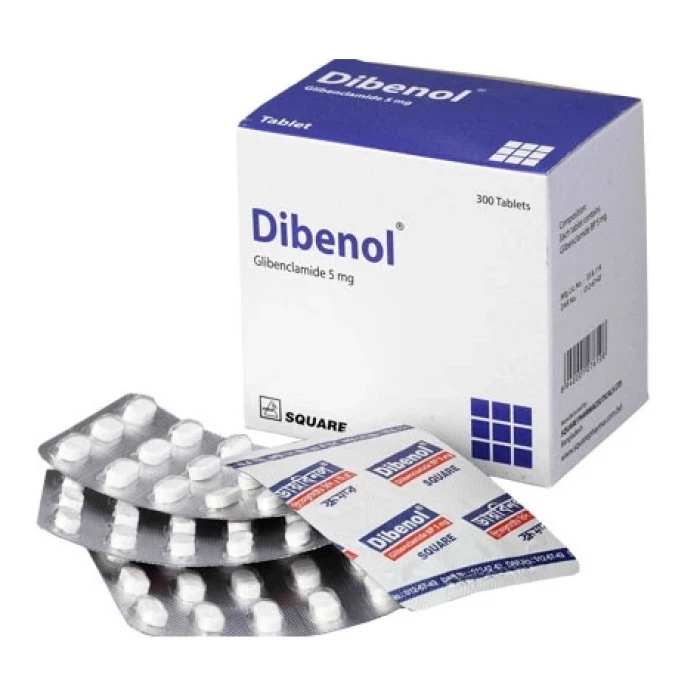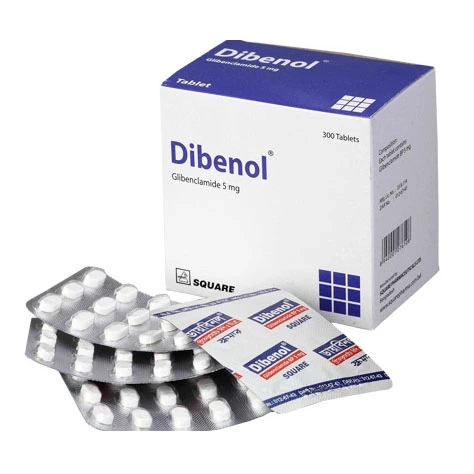
✔ 100% Authentic Product
👁️ Currently Viewing 1913
Dibenol 5mg Tablet 15pcs
Glibenclamide works by stimulating the release of insulin from the pancreas, specifically from the functioning beta cells in the pancreatic islets. While it effectively lowers blood glucose, the exact mechanism of how it continues to work over long-term administration remains unclear. The drug produces mild diuresis by enhancing renal free water clearance, which also contributes to blood glucose lowering.
Discount
Price: ৳ 5
MRP:
৳
5.25
6%
Off
✅ Description:

Use as directed by a registered healthcare professional.
✔️ Side Effects of Dibenol 5
Severe hypoglycemic reactions, including coma, seizure, or neurological impairment, are rare but can occur. Other common side effects may include mild hypoglycemia symptoms.
✔️ Dosage & Administration of Dibenol 5
There is no fixed dosage regimen for Glibenclamide. The following guidelines are typically recommended:
- Initial dose: 2.5 to 5 mg daily, taken with breakfast or the first main meal.
- For sensitive patients: Start with 1.25 mg daily.
- Maintenance dose: 1.25 to 20 mg daily, either as a single dose or divided doses.
- Dosage increases should be made in increments of no more than 2.5 mg per week, based on blood glucose response.
- Maximum dose: Do not exceed 20 mg daily.
Use as directed by a registered healthcare professional.
✔️ Uses of Dibenol 5
- Type 2 diabetes mellitus
✔️ Interaction
The hypoglycemic effect of Glibenclamide may be enhanced by the following drugs:
- Nonsteroidal anti-inflammatory agents (NSAIDs), ACE inhibitors, fluoxetine, clarithromycin, salicylates, sulfonamides, chloramphenicol, probenecid, monoamine oxidase inhibitors (MAOIs), and beta-adrenergic blockers.
- Risk of hypoglycemia: If these drugs are used alongside Dibenol, close monitoring for hypoglycemia is required.
- Hyperglycemic drugs: Thiazides, corticosteroids, phenothiazines, thyroid products, estrogens, oral contraceptives, phenytoin, nicotinic acid, sympathomimetics, calcium channel blockers, and isoniazid may counteract the effects of Glibenclamide and may lead to hyperglycemia.
- Oral miconazole: May interact with oral hypoglycemic agents like Glibenclamide and lead to severe hypoglycemia.
✔️ Glibenclamide should not be used in patients with:
- Known hypersensitivity to Glibenclamide or any of its excipients.
- Type 1 diabetes mellitus or diabetic ketoacidosis, with or without coma. These conditions should be treated with insulin.
✔️ Pregnancy & Lactation
- Pregnancy Category C: No significant evidence of harm to the fetus in human studies, although the drug should only be used when the benefits outweigh potential risks.
- It is not known whether Glibenclamide is transferred to human milk, but other sulfonylureas have been found in breast milk. Caution is recommended when using during lactation.
✔️ Precautions & Warnings
- All sulfonylureas, including Glibenclamide, can cause severe hypoglycemia. Proper patient selection, correct dosing, and adequate instructions are critical to avoid hypoglycemic episodes.
✔️ Storage Conditions
- Store below 30°C, protected from light and moisture.
- Keep out of reach of children.
⚠️Disclaimer:
At ePharma, we’re committed to providing accurate and accessible health information. However, all content is intended for informational purposes only and should not replace medical advice from a qualified physician. Please consult your healthcare provider for personalized guidance. We aim to support, not substitute, the doctor-patient relationship.






